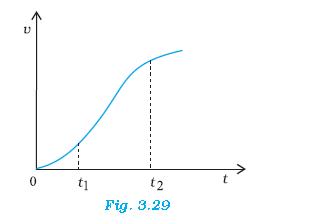the graph is not a straight line so acceleration is not constant and thus we cannot use instantaneous value of acceleration which are being used in options a and b.
3.28 The velocity-time graph of a particle in one-dimensional motion is shown in
Fig. 3.29 :
Which of the following formulae are correct for describing the motion of the particle
over the time-interval t1to t2:
(a) x(t2 ) = x(t1) + v (t1) (t2 – t1) +(½) a (t2 – t1)2
(b) v(t2 ) = v(t1) + a (t2 – t1)
(c) vaverage = (x(t2) – x(t1))/(t2 – t1)
(d) aaverage = (v(t2) – v(t1))/(t2 – t1)
(e) x(t2 ) = x(t1) + vaverage (t2 – t1) + (½) aaverage (t2 – t1)2
(f) x(t2 ) – x(t1) = area under the v-t curve bounded by the t-axis and the dotted line
shown.
pls explain why the options a,b and e are ruled out.
-
UP 0 DOWN 0 0 5

5 Answers
in(e)
x(t2)-x(t1) - (1/2)aaverage(t2-t1)2=Vaverage(t2-t1)
Vaverage=[x(t2)-x(t1)]/(t2-t1) -(1/2)aaverage(t2-t1)
But by definition Vaverage=[x(t2)-x(t1)]/(t2-t1) only
thats why e is ruled out